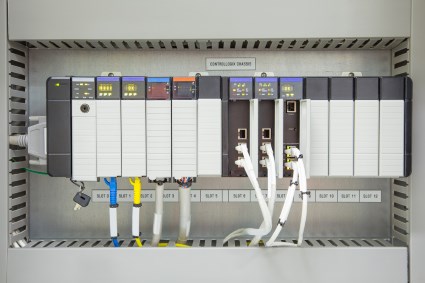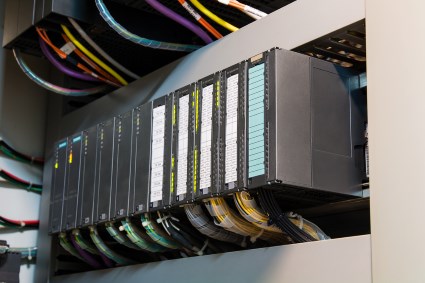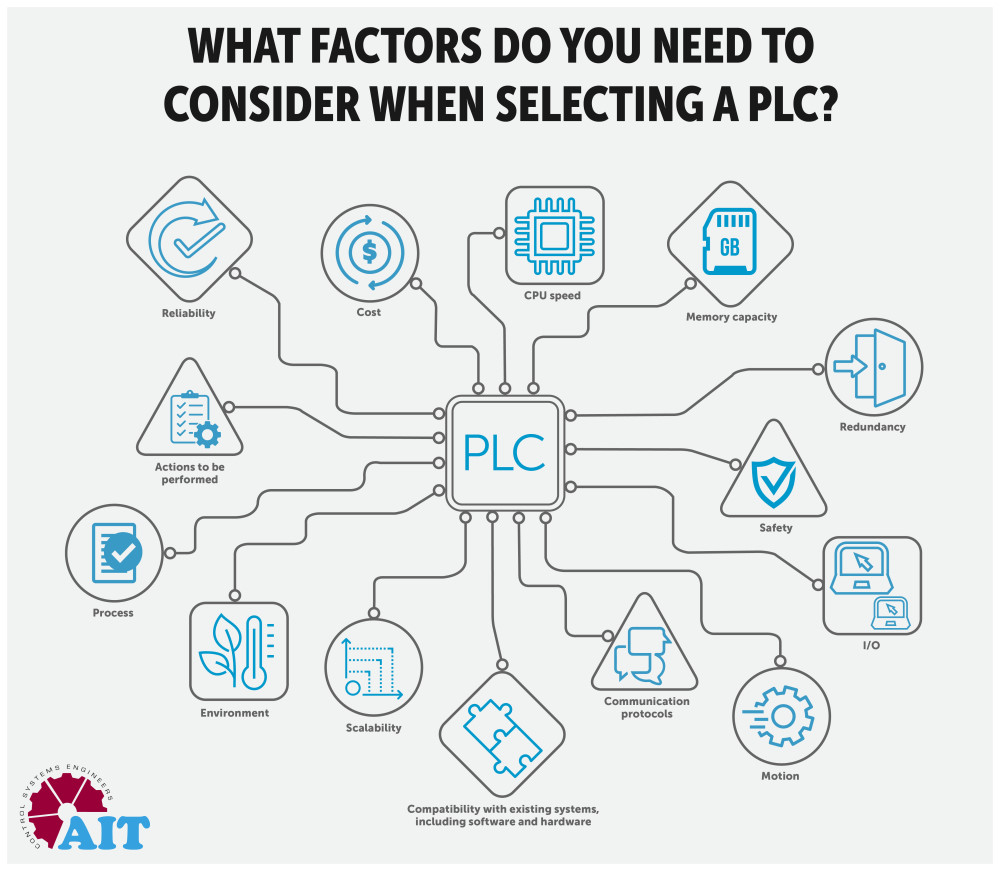Choosing a PLC: Things to consider
In a previous article we looked at the differences between cold, warm and hot redundancy, and how to determine which of these is best suited for your application. Here, we continue this discussion, looking at what to consider when selecting a programmable logic controller (PLC), as well as some of the different vendors available.
Considerations when selecting a PLC
There are a wide range of PLCs available for almost any application, so which brand or type would be ‘best suited’ for a particular project?
There are many considerations that should be taken into account to help narrow down the options for a particular application:
- CPU speed – how big is the system and what response rate does the process require?
- Memory capacity – how much memory is enough? Will an external memory card be required?
- Redundancy – is any level of redundancy required?
- I/O – how many devices does it need to control or monitor? Is there a requirement to work with external or remote I/O interfaces?
- Communication protocols – what devices will it need to communicate with and what protocols are used?
- Compatibility – is the system being built from scratch, or does it need to interface with existing hardware and software?
- Scalability – can the system be scaled up or down to accommodate changes with the system?
- Environment – what type of environmental conditions will it be subjected to? Will it require any special considerations such as conformal coated components, or a more robust option for harsh environments?
- Actions performed - does it need to be able to perform any unique actions, such as motion control, robotics or safety?
- Reliability – is the system expected to run with little or no downtime for extended periods of time, sometimes years?
- Cost – what is the budget? Have things been considered collectively as a ‘system’, such as the purchase of hardware, software licenses, programming, installation, ease of interface with existing plant/systems, maintenance, and back-up support along with any future upgrade considerations?
PLC brands: what’s the difference?
Allen Bradley
Allen Bradley offers a variety of PLC systems including its main flagship platform ControlLogix, along with the smaller sized CompactLogix and MicroLogix.
The ControlLogix and CompactLogix are modular systems that offer a wide choice of processors with different options based on memory sizes, on-board communication requirements, redundancy, safety integration and environmental considerations (extended temperature, conformal coating, etc.).
The ControlLogix platform consists of a separate base chassis, or rack, power supply, processor, I/O and communications modules. There are multiple configuration options available, from small single processor systems with a minimal I/O, to large redundant systems with an extensive I/O count and multiple remote I/O drops, all of which are scalable.
The cost for a ControlLogix system is the highest of the Allen Bradley PLC range, however this is reflected in its proven long life and reliability along with its large-scale control system capabilities. Where criticality or reliability is paramount, ControlLogix is the preferred platform.
CompactLogix consists of a separate power supply, processor and I/O modules, with or without on-board communications, all of which is DIN rail mounted. CompactLogix is typically used where a smaller system or cost is a consideration, although still designed with long life and expandability options.
The MicroLogix is a small ‘brick’ style PLC with a built-in power supply, processor and I/O with expansion modules available. The MicroLogix system is designed for smaller process and automation control tasks or can be integrated into a larger CompactLogix or ControlLogix system.
For those looking to upgrade an existing Allen Bradley system, all new products have good backward compatibility and legacy support, ensuring there is a migration path from previous models. Product software is also upgraded when a new product comes out to ensure any new hardware features are supported.
Allen Bradley’s support service is among the best of the PLC vendors, however there is a charge for programming software, and customers are required to pay an additional annual support fee in order to upgrade and receive the support.

General Electric
General Electric, or GE, has a long history of PLC hardware and software development. The legacy 90-30 and 90-70 series are being merged and replaced by the PACSystems RX3i series.
The RX3i controller provides the foundation for industrial Internet connectivity. It is a powerful, modular Programmable Automation Controller with a focus on high availability. The RX3i features a single control engine and a universal programming environment to provide application portability across multiple hardware platforms.
With integrated critical control platforms, logic, motion, HMI, process control and high availability based on GE Reflective Memory technology, RX3i increases system performance and flexibility. The RX3i platform contains a range of processors from relatively low-cost offerings through to very high performance redundant systems with true hot standby capability.
The RX3i CPE400 is the flagship CPU and has an incredible amount of power compared to almost any other PLC on the market, including a 4-core processor and 64MB of built-in RAM. The CPE400 also has a suite of built-in advanced security including Achilles Level 2 certification, so it can mitigate security and operational risks to the control system.
The compact range of GE PLCs consists of the Versamax Micro and Nano controllers which offer a low-cost entry point option. The Versamax standard range is pitched at small to medium systems before the RX3i takes over for larger systems.
At the time of writing, GE PLC’s were automating the processes that generate half of the world’s power!
Siemens
Siemens has a wide range of PLC options available, from basic controllers through to large-scale redundant platforms utilised on some of the world’s largest and most complex engineering projects.
The current flagship of Siemens PLC range is the S7-1500 advanced controller, with a 1ns ‘bit processing time’ in the CPU and features such as built-in Profinet, 4-Level security, integrated display and native OPC UA accessibility. The S7-1500 is one of the most feature rich PLC platforms on the market today.
In addition to the advanced S7-1500, Siemens has the range of industry proven S7-300 and S7-400 controllers, the latter of which provides a full redundancy option. One of the features of its S7 PLC range is that it can offer two safety runtime groups, which means the infrastructure can be divided into two groups with each section having different control parameters, including priorities and time cycles. The benefit of this is that operators don’t need to stop any processes when modifying the programing blocks and downloading them to the PLC.
Historically, the Siemens S7 PLC programming environment could be challenging for the uninitiated, however the latest Total Integrated Architecture (TIA) software suite provides a wide range of programming options that makes it easier than ever to configure and set up not only PLCs, but HMIs, drives and other associated Siemens equipment. Siemens also offers standard technical support for free.

Omron
Omron has a wide range of PLC options including rack mount, modular and compact versions. Compared to other PLC vendors, Omron typically provides lower costs options for hardware, software and licenses. However, when considering a complete system, additional programming time is typically required due to the nuances of the Omron programming environment, so the benefits of lower component costs can be offset by additional engineering costs.
Omron PLCs are high performing, flexible, reliable and relatively easy to integrate, although currently only have software-based redundancy. Omron has a good reputation in the manufacturing industry for its advanced controllers, which are capable of multi-axis motion control, vision systems, robotics, sensing and safety. Many of Omron’s connected devices integrate seamlessly with a PLC system to provide a complete system.
Schneider Electric
Schneider Electric’s main PLC range, Modicon, provides various platforms of all sizes from small brick style controllers through to the M340 and M580 redundant system and numerous legacy systems like Quantum, Premium and Momentum. Schneider Electric PLCs, PACs and dedicated controllers are easy to program, commission, maintain and are IIOT ready.
This range is particularly good in applications where hot redundancy is required as the Ethernet/IP standards have been incorporated, allowing for deterministic distributed I/O.
PLC to PLC communications is very easy with Schneider Electric’s Unity software and it is favoured by many engineers for this reason. The local support within Australia is quite extensive with large offices in most major cities.

Taking the stress out of PLC choice
With so much to consider around PLC selection, it can get a bit overwhelming. Employing the services of an experienced electrical and control systems engineering company such as Automation IT can ensure you’re getting the right PLC to meet the specific requirements of your specific application.
Automation IT is vendor neutral—catering for all major vendors—and can help match a client’s requirements to the right PLC that will allow them to get the most out of their control system and assets.
With a focus on providing clients with a high value, end-to-end solution, Automation IT’s certified engineers can provide you with a solution that complies with all laws, standards and warranties


